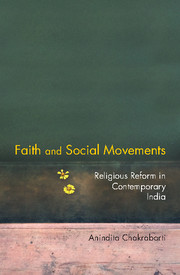Book contents
- Frontmatter
- Contents
- List of Figures
- Preface
- Acknowledgments
- Introduction: Dissent, Religion and Civil Society
- Part I Svadhyaya Ethics and the Spirit of Voluntarism
- 1 Theologies of Self-reform: What Transforms the Cross?
- 2 Praxis of an Emergent Congregation: Metaphysics of Reform and Rebirth
- 3 The Structure of Lokasaṃgraha: Volunteers, Networks and Training
- 4 Succession, Routinization of Charisma and Judicial Religion
- Part II The Tablighi Jamaat's Call for Self-reform
- Conclusion: Religion, Movements and Secularity
- Glossary
- Bibliography
- Index
3 - The Structure of Lokasaṃgraha: Volunteers, Networks and Training
from Part I - Svadhyaya Ethics and the Spirit of Voluntarism
Published online by Cambridge University Press: 28 February 2018
- Frontmatter
- Contents
- List of Figures
- Preface
- Acknowledgments
- Introduction: Dissent, Religion and Civil Society
- Part I Svadhyaya Ethics and the Spirit of Voluntarism
- 1 Theologies of Self-reform: What Transforms the Cross?
- 2 Praxis of an Emergent Congregation: Metaphysics of Reform and Rebirth
- 3 The Structure of Lokasaṃgraha: Volunteers, Networks and Training
- 4 Succession, Routinization of Charisma and Judicial Religion
- Part II The Tablighi Jamaat's Call for Self-reform
- Conclusion: Religion, Movements and Secularity
- Glossary
- Bibliography
- Index
Summary
The trouble with Socialism is that it takes too many evenings—
Oscar WildePillion-riding on her two-wheeler, I chatted with Chetnaben. She said that at the kendra, they were going to debate whether one should go on pilgrimages (tīrthas) or not. They would then discuss the original concept of tīrthayātrā. In ancient times, people used to go to tīrthas by foot across many villages. During the course of their pilgrimage, people from various regions and backgrounds had close interactions with each other. But now as they travelled mostly in air-conditioned coaches, the human relation that was present earlier is missing.
Field Diary, March 2001, Surat cityIf lokasaṃgraha is the task at hand for Svadhyayis, how do they create a leadership structure within the communities? How do women take up important leadership roles and the entire network function from small villages of Gujarat to Mumbai? Sociologists have drawn attention to the fact that sectarian affiliation has very often provided an important linkage between urban and rural India. It is interesting to note that Svadhyaya has been successful in both urban and rural areas, something which is difficult for movements to achieve. But how did Svadhyaya spread from its place of origin and gain acceptance in different local communities? I was eager to see Svadhyaya in the village context and know how and why people committed their ‘too many evenings’ to the movement. In the field, I followed its everyday activities but very soon realized that it was not easy to decipher its organizational structure. This chapter discusses the intricacies of the volunteer networks and the structure of leadership from Mumbai down to the villages.
In Svadhyaya, the volunteers run the show spending their own time and money with minimal formal structures. Initially, it was very difficult for me to reckon who held authority and who did not. When I mistook an office-bearer for a leader, I was politely cautioned that though he was an ‘active’ Svadhyayi it would be better if I spoke to X.
- Type
- Chapter
- Information
- Faith and Social MovementsReligious Reform in Contemporary India, pp. 88 - 111Publisher: Cambridge University PressPrint publication year: 2017



